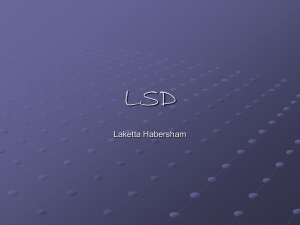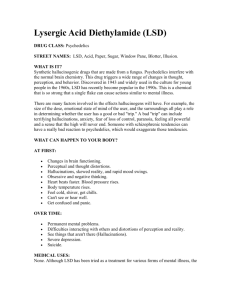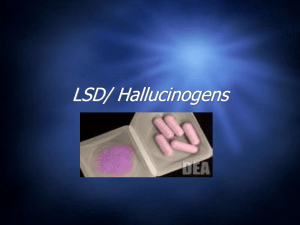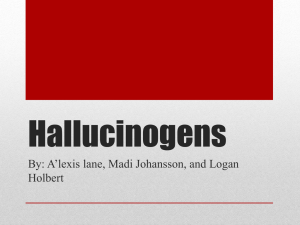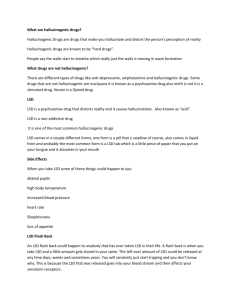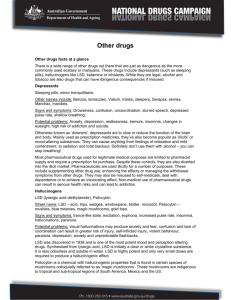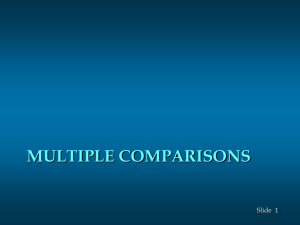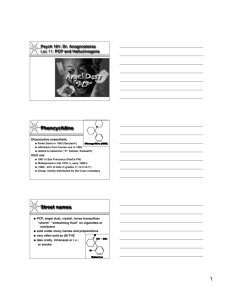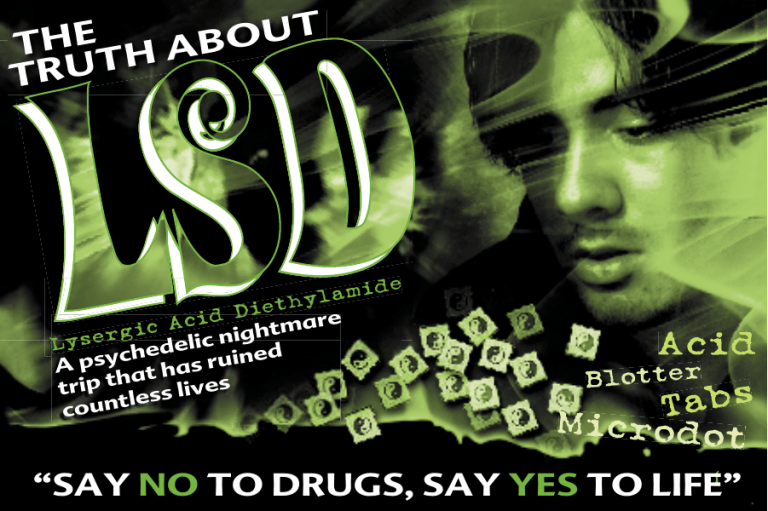
THE H ABOU
TRUT
T
D
S
L
ide
ylam
ieth
D
d
i
are
Ac
rgic
ightm
Lyse
cn
edeli
h
c
y
ined
s
Ap
as ru
h
t
a
h
trip t ess lives
tl
n
cou
Acid
Blotter
abs
MicroTdot
1
“SAY NO TO DRUGS, SAY YES TO LIFE”
WHY THIS BOOKLET
WAS PRODUCED
D
rugs destroy millions of lives every year. The most
disturbing aspect of this problem is the damage drug
abuse does to our young people — and the threat this
represents to the future of every country. With more
and more young people being introduced to drugs, it
is vital to provide educational materials with factual
information about their dangers.
This booklet is dedicated to those individuals and
organizations working to salvage others from the
ravages of drug abuse. Society owes them a debt of
gratitude for their cooperative efforts and we hope this
booklet will assist them.
Sadly, some in society seek to promote and spread drug
use for prot or gain — a fact that has been exposed too
many times for anyone to be fooled.
What is LSD?
is one of the most potent,
mood-changing chemicals. It is
manufactured from lysergic acid, which is
found in ergot, a fungus that grows on rye
and other grains.
LSD
It is produced in crystal form in illegal
laboratories, mainly in the United States.
These crystals are converted to a liquid for
distribution. It is odorless, colorless, and has
a slightly bitter taste.
Known as “acid” and by many other names,
LSD is sold on the street in small tablets
(“microdots”), capsules or gelatin squares
(“window panes”). It is sometimes added to
absorbent paper, which is then divided into
small squares decorated with designs or
cartoon characters (“loony
toons”). Occasionally it
is sold in liquid form. But
no matter what form
it comes in, LSD leads
the user to the same
place — a serious
disconnection from
reality.
LSD users call an LSD
experience a “trip” —
which is typically 12
hours or so. Adverse
reactions are called
“bad trips,” an appropriate name for a
taste of living hell.
3
Street Names for LSD
LSD
is most commonly referred to as “acid”. Other street names
include:
4
• Battery acid
• Boomers
• Doses
• Dots
• Golden Dragon
• Hippie
• Loony toons
• Lucy in the sky
with diamonds
• Microdot
• Pane
• Superman
• Tab
• Window pane
• Yellow sunshine
• Zen
• and many others
t the age of 16 I was introduced to
a drug that I abused for over three
years — LSD. What I was unaware of
was the fact that LSD is the most potent
hallucinogen known to man.
“The drug came on a small piece of
paper no bigger than my index finger
called a blotter. Fifteen minutes after
putting the paper on my tongue my entire
body got hot and I began to sweat.
“Some other reactions that I
experienced while on the drug included
dilated pupils, nausea and ‘goose bumps.’
While high on LSD I felt like there was a
huge distortion both in my mind and body.
The visual changes as well as the extreme
changes in mood were like some strange
scary trip — one in which I felt like I had
no control over my mind and body.”
— E.C.
A
“
5
What are the risks of LSD?
T
he effects of LSD are unpredictable. They
depend on the amount taken, the person’s
mood and personality, and the surroundings
in which the drug is used. It is a roll of the
dice — a racing, distorted high or a severe,
paranoid low.
Normally, the rst effects of LSD are
experienced 30 to 90 minutes after taking the
drug. Often, the pupils become dilated. The
body temperature can become higher or lower,
while the blood pressure and heart rate either
increase or decrease. Sweating or chills are not
uncommon.
LSD users often experience loss of appetite,
sleeplessness, dry mouth and tremors.
Visual changes are among the more
6
common effects — the user
can become xated on the
intensity of certain colors.
Extreme changes in mood,
anywhere from a spacedout “bliss” to intense terror,
are also experienced. The
worst part is that the LSD
user is unable to tell which
sensations are created by
the drug and which are
part of reality.
Some LSD users
experience an intense
bliss they mistake
for “enlightenment.”
“ would stay up for
I
days at a time binging.
Eventually I had lost a lot
of weight; I looked like
walking death and was a
disgrace to everyone who
loved me.”
— T.C.
On LSD, which is often taken
in tab form (left), an intense,
altered state transforms into
disassociation and despair.
Often there is no stopping
“bad trips,” which can go on for
up to 12 hours.
7
Not only do they disassociate from their usual
activities in life, but they also feel the urge to
keep taking more of the drug in order to re-experience the same sensation. Others experience
severe, terrifying thoughts and feelings, fear of
losing control, fear of insanity and death, and
despair while using LSD. Once it starts, there is
often no stopping a “bad trip,” which can go on
for up to 12 hours. In fact, some people never
recover from an acid-induced psychosis.
Taken in a large enough dose, LSD produces
delusions and visual hallucinations. The user’s
sense of time and self changes. Sizes and
shapes of objects become distorted, as do
movements, colors and sounds. Even one’s
sense of touch and the normal bodily sensations turn into something strange and bizarre.
Sensations may seem to “cross over,” giving
the user the feeling of hearing colors and
seeing sounds. These changes can be
frightening and can cause panic.
8
The ability to make sensible judgments and
see common dangers is impaired. An LSD user
might try to step out a window to get a “closer
look” at the ground. He might consider it fun to
admire the sunset, blissfully unaware that he is
standing in the middle of a busy intersection.
Many LSD users experience ashbacks, or
a recurrence of the LSD trip, often without
warning, long after taking LSD.
Bad trips and ashbacks are only part of the
risks of LSD use. LSD users may manifest
relatively long-lasting psychoses, such as
schizophrenia or severe depression.
Because LSD accumulates in the body, users
develop a tolerance for the drug. In other
words, some repeat users have to take it in
increasingly higher doses to achieve a “high.”
This compounds the physical effects and
increases the risk of a psychosis-inducing
bad trip.
t 13 years of age I took my first drink and soon after was
introduced to marijuana. Then LSD quickly fell into my
hands and I became addicted, eating it like candy.
“One night during one of my binges I blacked out and
awoke with blood all over my face and vomit coming out
of my mouth. By some miracle I pulled myself awake and
cleaned myself up. I got into the car, shaking, drove to my
parent’s house. I climbed into bed with my mom and cried.
“By the age of 21, I checked into my first rehab.”
— Donna
A
“
9
The Harmful EFFECTS OF LSD
Physical effects
Mental Effects
• Dilated pupils
• Higher or lower body
temperature
• Sweating or chills
(“goose bumps”)
• Loss of appetite
• Sleeplessness
• Dry mouth
• Tremors
• Delusions
• Visual hallucinations
• An articial sense of
euphoria or certainty
• Distortion of one’s sense
of time and identity
• Impaired depth
perception
• Impaired time perception,
distorted perception of
the size and shape of
objects, movements,
color, sounds, touch,
and the user’s own
body image.
• Severe, terrifying
thoughts and feelings
• Fear of losing control
• Panic attacks
• Flashbacks, or a
recurrence of the LSD
trip, often without
warning long after
taking LSD
• Severe depression or
psychosis.
“ started drinking at the age of
I
15. Then I progressed to taking
ecstasy, speed, cocaine and LSD.
“I found it difficult to hold
down a job and became
depressed and thought I would
never overcome my obsession
with drugs. I attempted suicide
twice by overdosing on pills. I
was put under psychiatrists who
gave me even more drugs, antidepressants and tranquilizers,
which just made matters worse.
“... as an outlet for my
feelings... I turned to self-harm
– I started cutting and burning
myself.”
— Justin
11
International statistics
I
n Europe, the highest use of LSD is in
the UK and Ireland (10 percent among
16 to 29-year-olds have used it at least
once), with lower percentages in the other
European countries.
In America, since 1975, researchers funded
by the National Institute on Drug Abuse
have annually surveyed nearly 17,000 high
school seniors nationwide to determine
trends in drug use and to measure the
students’ attitudes and beliefs about drug
abuse. Between 1975 and 1997, the lowest
period of LSD use was reported by the class
of 1986, when 7.2 percent of high school
seniors reported using LSD at least once in
their lives.
The percentage of seniors reporting LSD use
at least once over the course of the prior year
nearly doubled from a low of 4.4 percent in
1985 to 8.4 percent in 1997. In 1997, 13.6
percent of seniors had experimented with
LSD at least once in their lifetimes.
By 2004, an estimated 23.4 million Americans
over age 12 had used LSD at least once in their
lifetimes. That is 9.7 percent of this age group.
LSD POTENCY
LSD is 100 times
more potent
than psilocybin
mushrooms
An LSD user tells his story:
“ started hanging out at strip
clubs, casinos and became very
promiscuous, visiting brothel after
brothel and soon to be introduced to
other drugs.
“I had now lost all my inheritance
and had to move into a crack-house
where I stayed for a year watching
people die, losing my business and
becoming a thief.
“I was arrested in November 2003
for attempted hijacking and went to
prison.
“I had hurt and lost everyone that
loved me and I was disowned.
“I ended up homeless and on
the streets living and sleeping in a
cardboard box by [the train] Station,
begging and struggling to find ways
to get my next meal.”
— Frederick
I
LSD: Most powerful hallucinogenic
(mind-altering) drug
LSD is 4000
times stronger
than mescaline
LSD
4000X
LSD
100X
Psilocybin
and psilocin
Mescaline
LSD: A short history
A
lbert Hofmann, a chemist working for
Sandoz Pharmaceutical, synthesized LSD
for the rst time in Basel, Switzerland, while
looking for a blood stimulant. However, its
hallucinogenic effects were unknown until
1943 when Hofmann accidentally consumed
some LSD. It was later found that an oral
dose of as little as 25 micrograms (equal in
weight to a few grains of salt) is capable of
producing vivid hallucinations.
Because of its similarity to a chemical present
in the brain and its similarity in effects to
certain aspects of psychosis, LSD was used in
experiments by psychiatrists from the 1940s,
1950s and 1960s. While the researchers
failed to discover any medical use for the
drug, the free samples supplied by Sandoz
Pharmaceuticals for the experiments were
distributed broadly, leading to wide use of
this substance.
LSD was popularized in
the 1960s by individuals
like Timothy Leary, who
encouraged American
students to “turn on,
tune in, and drop out.”
This created an entire
counterculture of drug
abuse and spread the
drug from America to
the United Kingdom
and the rest of Europe.
Even today, use of LSD
in the United Kingdom
is signicantly higher
than in other parts of
the world.
Harvard psychologist
Timothy Leary, who
promoted LSD and
other mind-bending
psychiatric drugs, was
arrested and imprisoned
for drug-related crimes.
Psychiatric mind-control
programs focusing on LSD and
other hallucinogens created a
generation of acidheads. With
a more recent revival of LSD
use, the legacy of destroyed
lives continues.
16
While the 60s counter-culture used the
drug to escape the problems of society,
the western intelligence community and
the military saw it as a potential chemical
weapon. In 1951, these organizations began
a series of experiments. U.S. researchers
noted that LSD “is capable of rendering
whole groups of people, including military
forces, indifferent to their surroundings and
situations, interfering with planning and
judgment, and even creating apprehension,
uncontrollable confusion and terror.”
Experiments in the possible use of LSD to
change the personalities of intelligence
targets — and to control whole populations
— continued until the United States
ofcially banned the drug in 1967.
Use of LSD declined in the 1980s, but picked up
again in the 1990s. Since 1998, LSD became
more widely used at dance clubs and all-night
raves by older teens and young adults.
T
he days following my
LSD use, I was filled
with anxiety and extreme
depression. Following my
first ‘trip’ on LSD, I would
eat it frequently, sometimes
up to four or five times
per week for an extended
period. Each time I would
take the drug, mentally, I
was drifting more and more
out of reality. The eventual
effect was the inability to
feel normal in my own skin.”
— Andrea
“
17
R
ock bottom, what does it mean?… I heard it
being said time and time again, I mean how
many times does one have to throw everything and
anything away because of a temporary high? I love
sports [and] won the Jet-Ski championships, played
ice hockey and got colors for roller hockey.
“Then it all began. It started with the weed,
then the pills (ecstasy) and acid, making cocktails
of all sorts of drugs, even overdose to make the
rushes last longer. I took copious amounts of
these chemicals every day for as long as 2
years until I had a bad trip one night and went
into toxic psychosis. I prayed and cried for this
feeling to go away, I had voices in my head, had
the shakes and couldn't leave home for 6 months.
I became very withdrawn and thought everyone
was watching me, I couldn't walk in public places.”
— B.K.
“
19
The Truth
About Drugs
D
rugs are essentially poisons. How
much is taken determines the effect.
A small amount gives a stimulant
(increases activity). A greater amount acts
as a sedative (suppresses activity). A still
larger amount acts as a poison and can
kill one.
This is true of any drug. Only the amount
needed to achieve the effect differs.
But many drugs have another liability: they
directly affect the mind. By reactivating
incidents from a person’s past, below his
20
conscious awareness, they can distort the
drug user’s perception of what is happening
around him. As a result, the person’s actions
may be odd, irrational, inappropriate and
even destructive.
Drugs block off all sensations, the
desirable ones with the unwanted. So,
while providing short-term help in the
handling of pain, they also wipe out ability,
alertness and muddy one’s thinking. Longterm drug use robs life of the pleasures and
joys which are the only reasons for living
anyhow.
The real solution, however,
is not to begin using
drugs in the rst place.
Taking drugs is not
an answer.
In the end, one has a choice between
being dead with drugs or being alive without them.
As terrifying as the consequences of drug
use are, and as hopeless as they can seem
to the addict, there are solutions to the drug
problem and, on a broader scale, the war on
drugs can be won.
The rst step is to understand why a person
becomes trapped by drugs. In May 1969,
when the international drug crisis was reaching its peak, author and humanitarian L. Ron
Hubbard wrote, “When a person is depressed
or in pain and where he nds no physical relief
from treatment, he will eventually discover
for himself that drugs remove his symptoms.
“In almost all cases of psychosomatic pain,
malaise or discomfort the person has sought
some cure for the upset.
22
“When he at last nds that only drugs give
him relief he will surrender to them and
become dependent upon them often to the
point of addiction.”
Growing up and living in this world can be
very hard. Exercise, diet or simply taking
a long walk to look at things until one can
focus one’s attention outward and again
feel relaxed can work wonders. Talking
problems over with a friend or a minister or
trusted family member can also help.
And for the person with a drug problem,
there are also real solutions to their addiction. Narconon, a drug rehabilitation
program that utilizes the methods of L. Ron
Hubbard, has a success rate of more than 75
percent. (www.narconon.org)
The best solution, however, is not to begin
using drugs in the rst place. Taking drugs is
not an answer. As difcult as it can be to
confront one’s problems, the consequences
that come with drug use are always worse
than the problem one is trying to avoid
when he or she begins to take drugs.
And the long slide into hell that comes as a
result of taking drugs is even worse.
REFERENCES
European Monitoring Centre for
Drugs and Drug Addiction–Annual
Reports for 2003 and 2004.
Narconon International
information on LSD “http://www.
narconon.org” www.narconon.org
United Nations Ofce of Drugs
and Crime, report on LSD, 1998.
U.S. Department of Justice,
National Drug Intelligence Center
report, May 2003.
U.S. Drug Enforcement
Administration report on LSD,
October 2005.
U.S. National Institute on Drug
Abuse, report on LSD, April 2005.
U.S. Ofce of National Drug
Control Policy report on
Hallucinogens, September 2005.
Acid Dreams, The Complete
Social History of LSD, the CIA, the
Sixties, and Beyond, Martin A.
Lee and Bruce Shlain, Grove Press,
(revised edition), March 1986.
www.drogues.gouv.fr. Website
of the French government’s
Interdepartmental Mission for
the Fight Against Drugs and Drug
Addiction.
Hopkins Medical News
U.S. Substance Abuse and Mental
Health Services Administration
PHOTO CREDITS: Page 5: DEA;
Page 14: The Albert Hofmann
Foundation; Page 15: AP/Timothy
Leary; DEA/Timothy Leary arrest.
“Say No to Drugs, Say Yes to Life” is a community
drug education and drug prevention program
initiated by the Church of Scientology International.
It educates children and youth about the dangers of
drugs and challenges them to remain drug-free and
to set a good example to their friends and family.
The program acts through clubs run by and for
young people. These clubs reinforce a positive
message of drug-free living through the distribution
of educational literature that provides facts about
illicit drug use and the effects of drugs on the
spirit, mind and body, through group activities to
popularize drug-free living, and through the support
of civic leaders and members of other groups with
similar aims.
Experience has taught us that people in general,
and youth in particular, when they understand
the destructive effects of drugs, and when they
are provided with positive role models and the
support of their peers to remain drug-free, they
inevitably come to the conclusion: “I don’t want
to take drugs” — which is of course the ultimate
purpose of the program.
23
“SAY NO TO DRUGS, SAY YES TO LIFE”
YES TO LI
Y
www.notodrugs-yestolife.org
GS
NO
U
SA
SA
To obtain more copies of this or the other booklets in this series, or to
learn more about the discoveries of L. Ron Hubbard and his workable
technologies that rid people of the harmful effects of drugs, visit or contact:
Y
FE
This booklet is presented as a public service by the Church of Scientology
International. It is part of a series of booklets to educate young people in
the truth about drugs. The booklets in this series provide the facts about
cannabis, crack and cocaine, crystal methamphetamine, ecstasy, heroin,
LSD, prescription painkillers and other addictive drugs, allowing the reader to
decide for himself to live a drug-free life.
R
T O D TM
Or Contact:
Say No to Drugs, Say Yes to Life Coordinator
Church of Scientology International
6331 Hollywood Boulevard, Suite 1200
Los Angeles, CA 90028
(323) 960-3500
or your local Church of Scientology
© 2006 Church of Scientology International. All Rights Reserved. Grateful acknowledgment is made to L. Ron Hubbard Library for permission to reproduce a selection from
the copyrighted works of L. Ron Hubbard. SCIENTOLOGY is a trademark and service mark owned by Religious Technology Center and is used with its permission. SAY NO TO
DRUGS, SAY YES TO LIFE logo is a trademark owned by CSI. NARCONON is a trademark and service mark owned by Association for Better Living and Education and is used
with its permission. Item #19813

